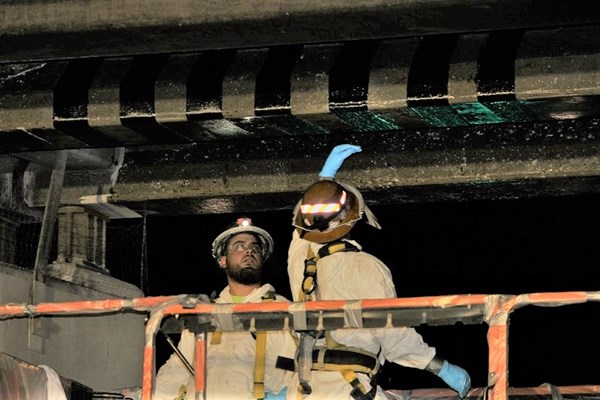Carbon fiber used to repair and strengthen Phoenix freeway bridges
FNF Construction Inc., of Tempe, Ariz. and FRP Construction of Tucson, were contractors on the I-17 bridge repairs, using a carbon fiber process for structural strengthening developed by a Tucson company, QuakeWrap Inc.
Saw a story on my local news that involved composites: The Arizona Department of Transportation (ADOT) said that it has used carbon fiber to help repair and strengthen girders on two Interstate 17 bridges in Phoenix. This marks the first time ADOT has used carbon fiber strips that are coated and strengthened with a reinforcing polymer to fix girders on state highway bridges, which in these two cases had been struck by over-height vehicles.
ADOT said that instead of other repair methods such as injecting epoxy to rebuild sections of the steel-reinforced concrete girders, crews used fiber-reinforced polymer to wrap the damaged girders. The repair work on the two I-17 bridges was completed in May.

The improvements were first done to the bridge carrying I-17 over 19th Avenue. That bridge’s sufficiency rating has now been upgraded, allowing ADOT to move it off the structurally deficit list.
The second repaired bridge, which carries Jefferson Street over I-17, wasn’t structurally deficient. Structurally deficient is kind of an alarming term, but ADOT says it doesn’t mean a bridge is unsafe to use but rather certain repair needs, including component replacement, have been identified through an inspection.
FNF Construction Inc., of Tempe, Ariz. and FRP Construction of Tucson, were contractors on the I-17 bridge repairs, using a carbon fiber process for structural strengthening developed by a Tucson company, QuakeWrap Inc.

“Our ADOT Bridge Group focuses on using new and innovative bridge-repair technologies that enhance safety while saving time and taxpayer dollars,” says ADOT Senior Bridge Engineer William Downes. “The reinforced fiber strips add strength to the girders and are designed to limit the amount of debris that could fall should a girder be struck again.”
“We think the carbon fiber repairs are effective, can extend the lifespan of structures and can be done in much less time than other repair methods,” says ADOT State Bridge Engineer David Eberhart. “We’re likely to use it again if and when repairs are needed.”
Related Content
-
TU Munich develops cuboidal conformable tanks using carbon fiber composites for increased hydrogen storage
Flat tank enabling standard platform for BEV and FCEV uses thermoplastic and thermoset composites, overwrapped skeleton design in pursuit of 25% more H2 storage.
-
Welding is not bonding
Discussion of the issues in our understanding of thermoplastic composite welded structures and certification of the latest materials and welding technologies for future airframes.
-
Infinite Composites: Type V tanks for space, hydrogen, automotive and more
After a decade of proving its linerless, weight-saving composite tanks with NASA and more than 30 aerospace companies, this CryoSphere pioneer is scaling for growth in commercial space and sustainable transportation on Earth.
















